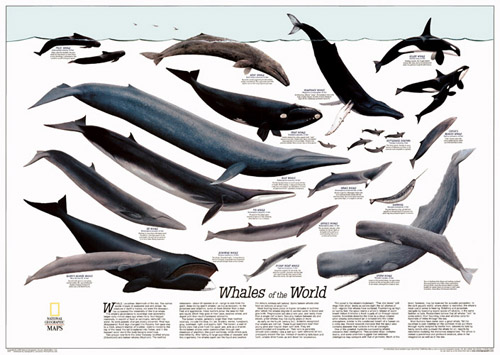|
Tell Me About Your Whale
A WebQuest on Different Types of Whales
Grade Level/Subject: 4th-6th Grade, Language Arts/Social Studies/Art
Length of Lesson: 2-3 hour
Designed by Abby Jones
jone8997@pacificu.edu

Introduction | Task | Process | Evaluation | Conclusion | Credits | Teacher Page
Introduction
You are a marine
biologist who studies whales for a living and you and a partner have
decided to compile a book of all the different whales in the world.It
is your task to get this book started and since there are so many
different types of whales it is your job to research one whale at a
time.
The
Task
The task is to gather
information on a whale of your choice and to compile that information
into an informative report. As a class you will gather all of your
reports to create a book about all the different types of whales in the
world. You are to use the sites listed below, as well as any you find
on your own to research your whale.
The
Process
- First you will pick a partner.
- Then you will choose a
whale to research. There are some websites listed below to help you
begin your search. Don't limit yourself to these websites, explore what
else is available before you choose.
- Once
you have picked a whale you and your partner will begin researching the
sights above and any other websites or books that will help you answer
these questions:
- Name of whale:
- Type of whale (baleen or toothed):
- What the whale eats:
- Where the whale is located:
- The dimensions (size) of the whale:
- Does the whale migrate? If yes, what is the migration pattern:
- How long the whale lives:
- And any other interesting facts you find:
- After
you have all of your data collected you and your partner will start to
compile it to create a rough draft for your report. The report should
be about a page in length.
- After you have written the rough draft, you and your partner will take turns revising and editing the report.
- Once you have your report edited how you like it, type it up on the computer. (Please use 14pt font in Times New Roman)
- Print out your report
and place it in the folder with the rest of the completed reports. The
folder is located in the back of the room on the counter.
- Lastly, you and your
partner will create a picture of your whale. You are allowed to use
anything you like to do your picture, just remember to take your time
and make it a good representation of what the whale really looks
like.
- If you used paint, let it dry. Otherwise, place your drawing in the folder next to your report.
Evaluation
The evaluation of your report will be graded on the criteria listed below. You will be graded as a group.
|
|
Beginning
1
|
Developing
2
|
Accomplished
3
|
Exemplary
4
|
Score
|
|
Report of
the whale
|
Each report at this score point is an ineffective presentation of the writer's ideas.
Incomplete paragraphs
Little or no organization
Little or no development of ideas
Does not engage the reader
Frequent errors in spelling, capitalization, punctuation, grammar, and sentence structure
|
Each report at this score point is a somewhat effective presentation of the writer's ideas.
Somewhat focused paragraphs
Organization not always smooth or completely logical
Little development of ideas, gaps of information missing
Moments where writer engages the reader
Some errors in spelling, capitalization, punctuation, grammar, and stentence structure
|
Each report at this score point is a generally effective presentation of the writer's ideas.
Paragraphs are mostly focused
Generally effective organizational strategy
Attempts to develop all ideas, some better than others
Engages the reader
Generally demonstrates good command of spelling, capitalization, punctuation, grammar, and sentence structure
|
Each report at this score point is a highly effective presentation of the writer's ideas.
Paragraphs are focused
Effective organizational strategy
Developed ideas, creates depth and thought
Engages the reader and sustains this connection throughout the report
Demonstrates a consistent command of spelling, capitalization, punctuation, grammar, and sentence structure |
|
|
Picture of whale
|
The artwork is incomplete and demonstrates little or no control over art materials
Students were consistently off-task during work time |
The artwork is mostly complete and demonstrates basic control over art materials
Students were consistently off-task during work time |
The artwork is complete and demonstrates adequate use of art materials
Students remained on-task demonstrating both effort and interest in their work |
The artwork is thoroughly complete and demonstrates an expert use of art materials
Students diligently completed work and demonstrated both enthusiasm and an outstanding effort |
|
Conclusion
After all of the groups
of finished their report and picture, we will decide as a class how we
should organize our book: alphabetical, type, size, etc. Once we have
figured out the order we will send the book off to production to be
bound. When we get the book back we will gather and share our reports
to the class. The book will remain with the other non-fiction books in
the back of the class as a reference. Enjoy and be proud of your book
on the whales of the world!!
Credits
& References
http://www.jrweldin.com/maps-reference.aspx
http://www.worldscreatures.com/water-species/whales/
http://en.wikipedia.org/wiki/List_of_whale_species
http://www.abc.net.au/oceans/whale/type.htm
http://students.estrellamountain.edu/drakuna/studentfront
pageprojects/JessicaPetro/FrontPageFinal/new_page_2.htm
http://www.42explore.com/whale2.htm
Last
updated on December 2, 2008.
Based
on a template from The
WebQuest Page
|
